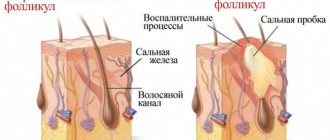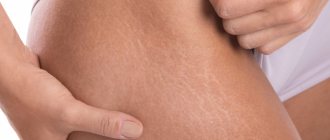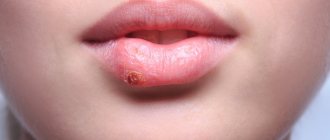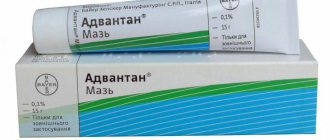During pregnancy, a woman's body changes under the influence of the endocrine system. As a result, in the first semester, the pregnant woman experiences sudden mood swings, perversion of taste and other symptoms characteristic of this period.
However, not only the internal state of a woman changes, but her body also undergoes serious changes. Small cracks appear on the skin of the abdomen and chest, which increase in length over time. Their relief can be lumpy or smooth, and the color changes in accordance with the stage of development of the striae.
Why do stretch marks appear during pregnancy? How to prevent their development? How to remove stretch marks on the skin if they have already appeared? What modern cosmetic methods allow you to get rid of them forever?
What are striae?
Stretch marks are small defects that form on the surface of the skin. They often appear in the thighs, abdomen, chest and buttocks. Externally, they appear as parallel or radial long strips that differ in color from the surrounding skin.
Initially they are red in color due to congestion of the vessels. As they become deserted, the striae first acquire a purple tint, then become white. They are called "old" stretch marks, the color changes 6 months after their appearance.
Due to a decrease in collagen and elastin, gaps form in the skin, which are replaced over time by connective tissue. They do not contain pigment, so when the skin tans, stretch marks become more noticeable.
Skin care
Everyone knows that the skin of a pregnant woman’s face sometimes seems to glow from within. This is due to the fact that due to hormonal changes, more blood flows to the face and it looks refreshed. However, pregnant women also experience skin problems.
Age spots are a very common occurrence during this period. They can appear on the face, stomach and chest. As a rule, they go away within 4–5 months after the birth of the child.
However, to reduce their expression on the face, dermatologists strongly recommend using sunscreen with SPF of at least 30, and also not neglecting foundation - this will make you feel attractive and confident. By the way, BB and CC creams successfully combine the functions of moisturizing, sun protection and skin toning.
Acne - peeling and rashes on the skin of pregnant women - is associated with changes in the hormonal balance in the body. Skin may become drier, more sensitive and more prone to irritation. Don't worry, this is temporary.
- Use sun protection.
- Choose a new moisturizer for sensitive skin.
- Cleanse your skin with soft facial foams.
- Use anti-acne products, but first make sure that they do not contain substances that are not recommended for pregnant women.
Why do stretch marks appear during pregnancy?
Stretch marks can appear on a pregnant woman’s body for several reasons:
Changes in hormonal levels. During pregnancy, the production of estrogen and cortisone decreases. As a result, the production of proteins (collagen and elastin) and elastic fibers located in the connective tissue is disrupted. At the same time, the skin loses its former tone and elasticity, and “dips” appear.
Sudden weight gain. During pregnancy, a woman gains weight - this is a physiologically determined process. However, if a pregnant woman gains over 5 kg in a short time, the skin quickly and incorrectly stretches. Small cracks form on its surface, which over time turn into a white scar.
Genetic predisposition. The hereditary factor is of great importance, therefore, stretch marks and other cosmetic defects do not form on the body of some women during pregnancy due to its high and rapid regeneration.
Insufficient skin care. Due to dryness, the skin loses nutrients and becomes tough. This is why it is important to moisturize your skin during pregnancy and after childbirth.
Weak muscles of the anterior abdominal wall. Due to low physical activity, stretch marks may appear on the abdomen. There are special exercises aimed at preventing the formation of stretch marks in the abdominal area, which will be discussed below.
In addition, due to poor nutrition, the content of vitamin E, or tocopherol, which protects the skin from damage, decreases in the pregnant woman’s body.
How do stretch marks appear?
Stretch marks form on the skin not only during pregnancy. Cosmetic defects, or stretch marks, can appear on the skin in adolescents, when gaining muscle mass, as well as in certain diseases (Cushing's syndrome, Marfan).
At first, a pregnant woman is bothered by itching on the skin, and scratches appear on its surface. Over time, small slit-like defects form that protrude above the skin. Sometimes their formation is asymptomatic; women notice them after the formation of a white scar.
How long does it take for stretch marks to appear?
During pregnancy, stretch marks on the abdomen often appear in the second trimester. This is due to a sharp increase in the belly of the chest due to the active growth of the child and hormonal changes. It is possible to prevent the appearance of stretch marks if you spend enough time on prevention.
Risk factors for stretch marks
Why do stretch marks appear on the skin? In addition to the main reasons listed above, there are factors that increase the risk of stretch marks on the skin of the thighs, chest and abdomen. Among them:
- Multiple pregnancy of the mother. Moreover, during pregnancy, the abdomen increases significantly in a short period of time, as a result of which the skin does not have time to recover and defects occur.
- A large fetus may also increase the risk of stretch marks on the skin of the abdomen.
- The age of a pregnant woman is an important factor in the formation of cosmetic defects on the surface of the skin. With age, it loses elasticity and firmness.
That is why the older a woman is, the higher the risk of developing stretch marks during pregnancy.
The hereditary factor also plays an important role in the formation of stretch marks, as mentioned above. If there are pronounced stretch marks on the skin of a pregnant woman’s mother in the abdomen and chest area, the expectant mother is likely to have them as well.
Why stretch marks occur
An increase in the size of the fetus and an increase in body weight provoke severe stretching of the woman’s skin, which leads to tissue rupture. Stretch marks during pregnancy occur due to the destruction of the reticular layer of the dermis.
Causes of stretch marks: poor diet; bad habits; lack of moderate physical activity; low physical activity; chronic swelling; cardiovascular or endocrine diseases. Lack of protein in a pregnant woman’s body is one of the main causes of rupture of connective tissue fibers. A lack of protein stops the production of the natural “building” element of tissue - collagen. This makes the skin less elastic and firm. In order for a pregnant woman’s body to receive as much protein as possible, it is important to regulate nutrition and make it complete and balanced.
How to prevent the appearance of stretch marks on the skin?
During pregnancy, it is important to follow the principles of prevention that will protect the skin from stretch marks. First, you need to add foods rich in vitamin E and C to the pregnant woman’s diet. Legumes are rich in vitamins and minerals, as well as green vegetables. You should give up sugar, it reduces the formation of collagen in the skin.
It is also necessary to monitor your water balance. If the pregnant woman is not bothered by body edema and there are no special recommendations from the supervising doctor, it is recommended to drink at least 1.5 liters of water per day. It is also necessary to monitor the nutrition of the skin, moisturize it with special creams and lotions, and use a hard-bristled brush when washing.
Moderate physical activity increases muscle tone. For this purpose there are special group classes in the gym. Women during pregnancy usually practice yoga. If physical exercise is contraindicated for health reasons, you should spend more time walking at a brisk pace.
How to get rid of stretch marks if you already have them
There is definitely no way to quickly reduce stretch marks - for proper cell regeneration, breakdown of excess collagen fibers and sufficient penetration of a special anti-stretch mark product deep into the epidermis, you will need to undergo a full course of treatment.
Physiotherapy and special aids
The procedures can be either simple applications of Fermenkol against stretch marks, or its combination with physiotherapy, for example, with electrophoresis - the choice of method for treating stretch marks depends on the degree of its complexity, the desired result and the presence of contraindications.
You can start treating stretch marks at 3-4 weeks , rubbing the product into the problem area with massage movements. However, before use, make sure that there is no allergy to the drug. To do this, just apply a small amount of cream to your palm and leave for 20 minutes. If there is no redness, feel free to use it.
Before starting a course of physical therapy, make sure that the chosen method is suitable for you, consult with your doctor.
Treatment can also be combined with light physical activity: gymnastics, walking, swimming will help to “accelerate” the blood, saturate the cells with oxygen and make the muscles elastic.
Striae: reasons
As mentioned above, stretch marks occur from sudden weight gain or loss; the skin simply does not have time to adapt to the new weight. It can be compared to a plastic bag: if you put more in it than it can handle, it stretches. The exact same thing happens with the skin.
But if previously it was believed that stretch marks were something irreparable, now there are many ways to get rid of stretch marks, the main thing is to accurately determine the cause of their occurrence.
- Endocrine disorders
and diseases lead to rapid and sharp weight gain or loss, as well as a decrease in the production of collagen and elastin. Moreover, with this type of disorder, stretch marks can even appear on the face, neck and back.
- Pregnancy and lactation period.
During this stage of a woman’s life, not only natural hormonal changes occur, but also an increase in body volume.
- Sudden weight fluctuations.
Incorrectly selected diets that lead to sudden changes in weight will definitely affect the condition of the skin, since it does not have time to respond properly to weight fluctuations, so it stretches, especially in areas of fat accumulation.
- Excessive physical activity.
If a person who is poorly prepared physically suddenly begins active sports or physically difficult work, then this load can provoke fiber ruptures, which later turn into striae.
- Age-related changes.
Skin stretching often occurs in adolescence, when the skin does not keep up with growth, and in old age, when many processes, including the production of collagen and elastin, slow down.
- Hereditary skin feature
renew fibers, retain moisture, etc.
White and red stretch marks
A few more words about what the color of the stretch marks says.
As we have already said, stretch marks can have different colors from white to blue-violet. At first (6-8 months) they have a bright color, pink or red, due to the fact that there are many blood vessels in the connective tissue that filled the place where the fibers broke.
But time will pass, and they will atrophy, since this is an unsuitable environment for them, and will become white, especially noticeable on tanned skin.
The fact is that connective tissue has also replaced the epidermal cells that produce melanin, which gives the skin its color. Interestingly, hair does not even grow in places where there are stretch marks and cellulite does not appear.
More about procedures
Fractional photothermolysis
TCA peeling
Body mesotherapy
Breast care during pregnancy
As a rule, everyone is ready for the fact that during pregnancy the breasts become larger - on average by 1 - 2 sizes. Her weight increases, and the ligaments cannot cope with the increased load. After breastfeeding is completed, it may become larger or smaller, everything is individual.
But if its size cannot be influenced, then is it possible to prevent the change in shape? Also, many women note that during pregnancy and childbirth, the nipples become larger and darker. Breast sensitivity may change during this period. What to expect?
1. As for the nipples, their size may decrease after breastfeeding ends, they may become lighter, but in each case everything is individual. The sensitivity of the nipples, as a rule, returns to the state it was before pregnancy.
2. Experts say that it is impossible to prevent changes in breast shape. This is a natural phenomenon. Here are some remedies you can resort to to make your breasts firmer:
2.1.1. after consulting with a specialist, do planks and other special exercises - they affect the pectoral muscles, and not the breast tissue, but nevertheless they can have an effect;
2.1.2. breast massage combined with almond, coconut or olive oil will improve skin tone. You need to be careful not to massage the nipple area, so as not to stimulate the production of oxytocin, which can cause uterine tone. It is recommended to do it about three times a week;
2.1.3. good posture, which can be achieved through yoga and gymnastics - as a result, the shape of the breasts improves;
2.1.4. It is recommended to wear special underwear, first of all, for comfort - during pregnancy, the breasts increase in size and need additional support.
Nails and hair during pregnancy
Great news: while expecting a baby, the expectant mother's nails become stronger, and her hair becomes shiny and thicker. Surprises are also possible: wavy hair can become straight, or vice versa.
- •\tIt is worth keeping in mind that the hair seems thick not because more hair has begun to grow, but because it is now falling out less. In normal life, on average, we lose about 100 hairs per day, and during pregnancy, the process of hair loss slows down significantly. After childbirth, the hair will return to its normal state.
- Many women are concerned about excess hair growth on the face and body - do not worry, this is temporary. Choose a hair removal method that is convenient for you. However, remember that depilatory creams are not considered completely safe for pregnant women.
- Also, you should not start using a home epilator if you have not had such experience before: as a rule, the number of ingrown hairs increases during pregnancy, and it is extremely difficult to deal with them, so it is better not to increase the likelihood of their occurrence.
Is it possible to dye your hair during pregnancy?
There is no scientific evidence confirming the dangers of using conventional paint with ammonia during pregnancy. However, it is recommended to temporarily switch to more gentle, possibly unstable, paints or coloring instead of classic coloring.
- During this period, you need to especially strictly follow the instructions for hair dyes - check them for allergenicity by applying a little dye to the skin and waiting the right time. Do not under any circumstances try to dye your eyebrows or eyelashes with hair dye: this is very dangerous and can lead to irreparable consequences, including blindness.
It is worth remembering that during this period it is not recommended to experiment with perm: firstly, the substances included in the special mixture may be unsafe for the child, and secondly, the hair does not behave as usual. The result may be unpredictable.
Which doctor to contact if stretch marks are detected: diagnosis
For diagnosis and treatment, you should first visit a dermatologist. You may also need to consult a cosmetologist, surgeon, endocrinologist and therapist. At the appointment, the doctor conducts an examination, studies complaints and anamnesis, and, if necessary, refers to other specialists and for additional examination.
Basic procedures:
- dermatoscopy;
- blood analysis;
- Analysis of urine;
- study of hormonal status (cortisone, testosterone and other hormones);
- ECG;
- Ultrasound;
- CT;
- MRI;
- craninography.
Treatment depends on the identified causes of stretch marks, their age, and the results of laboratory tests. It is possible to carry out such procedures as:
- injections;
- drugs in tablet form;
- laser therapy;
- phonophoresis;
- massage;
- wrap;
- phototherapy;
- plasma therapy;
- magnetic-thermal therapy;
- peelings of different types;
- complex of vitamins and minerals;
- wearing a bandage;
- wraps;
All the described treatment methods improve blood supply to the affected areas and improve their structure. Thanks to this, cells multiply better and the tissue recovers faster. As old cells are replaced by new ones, stretch marks gradually disappear.
But in some cases, when conservative therapy methods (medicines, procedures) do not work, surgical intervention has to be used. The operation is indicated only in extreme cases and is used relatively rarely.









